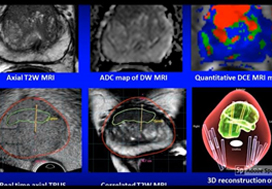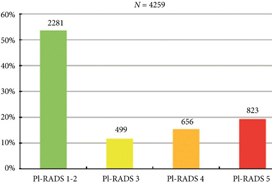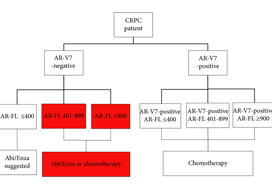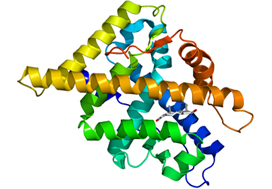
Editorial: Fusion‐guided biopsy to guide active surveillance in African‐American men?
This timely and important article by Bloom et al. [1] highlights findings that warrant special attention in an effort to address and reduce racial disparities in low‐risk prostate cancer. At the population level, African‐American (AA) men are 76% more likely to be diagnosed with prostate cancer and 2.2‐times more likely to die from prostate cancer compared with other men in the USA. Emerging evidence suggests that racial disparities in patients diagnosed with advanced stage or higher‐risk…

Video: Use of mpMRI and fusion‐guided biopsies to properly select and follow African‐American men on active surveillance
Use of multiparametric magnetic resonance imaging and fusion‐guided biopsies to properly select and follow African‐American men on active surveillance
Abstract
Objectives
To determine the rate of Gleason Grade Group (GGG) upgrading in African‐American (AA) men with a prior diagnosis of low‐grade prostate cancer (GGG 1 or GGG 2) on 12‐core systematic biopsy (SB) after multiparametric magnetic resonance imaging (mpMRI) and fusion biopsy (FB); and whether AA men who continued active…

Residents’ podcast: Artificial intelligence applications in urology
Maria Uloko is a Urology Resident at the University of Minnesota Hospital. In this podcast she is joined by Dr Christopher Weight, an Associate Professor in the Department of Urology at the University of Minnesota. They are discussing a recent BJUI Article of the month:
Current status of artificial intelligence applications in urology and their potential to influence clinical practice
Abstract
Objective
To investigate the applications of artificial intelligence (AI) in diagnosis,…

Article of the week: mpMRI and follow‐up to avoid prostate biopsy in 4259 men
Every week, the Editor-in-Chief selects an Article of the Week from the current issue of BJUI. The abstract is reproduced below and you can click on the button to read the full article, which is freely available to all readers for at least 30 days from the time of this post.
In addition to the article itself, there is an editorial written by a prominent member of the urological community and a video prepared by the authors. These are intended to provoke comment and discussion and we invite you…

Editorial: Avoiding biopsy in men with PI‐RADS scores 1 and 2 on mpMRI of the prostate, ready for prime time?
In 2019 is it safe to avoid prostate biopsy in men with Prostate Imaging Reporting and Data System (PI‐RADS) score 1 and 2 lesions reported on their multiparametric MRI (mpMRI)? In this journal, Venderink et al. [1] suggest that more than half the men being investigated for suspected prostate cancer could indeed safely avoid an initial biopsy. However, like other investigators in this field, the authors make an assumption in their study that there is such a paucity of clinically significant cancer…

Video: mpMRI and follow-up to avoid prostate biopsy in 4259 men
1 Comment
/
Multiparametric magnetic resonance imaging and follow-up to avoid prostate biopsy in 4259 men
Abstract
Objective
To determine the proportion of men avoiding biopsy because of negative multiparametric magnetic resonance imaging (mpMRI) findings in a prostate MRI expert centre, and to assess the number of clinically significant prostate cancers (csPCa) detected during follow‐up.
Patients and methods
Retrospective study of 4259 consecutive men having mpMRI of the prostate between…

Article of the week: Androgen receptor (AR) splice variant 7 and full‐length AR expression is associated with clinical outcome: a translational study in patients with castrate‐resistant prostate cancer
Every week, the Editor-in-Chief selects an Article of the Week from the current issue of BJUI. The abstract is reproduced below and you can click on the button to read the full article, which is freely available to all readers for at least 30 days from the time of this post.
In addition to the article itself, there is an editorial written by a prominent member of the urological community. These are intended to provoke comment and discussion and we invite you to use the comment tools at the bottom…

Editorial: Androgen receptor splice variant 7 (AR‐V7) and AR full‐length (AR‐FL) as predictive biomarkers of therapeutic resistance: partners in crime?
The prostate cancer treatment armamentarium has expanded over the last decade to include taxane‐based chemotherapies (docetaxel, cabazitaxel), sipulecel‐T, radium‐233, and newer androgen receptor (AR) signalling (ARS) inhibitors (abiraterone, enzalutamide, apalutamide). Despite these improvements, persistent ARS remains a key driver of prostate cancer progression after androgen‐deprivation therapy (ADT), transition to castrate‐resistant prostate cancer (CRPC), and even after resistance…

Article of the week: The global prevalence of erectile dysfunction: a review
Every week, the Editor-in-Chief selects an Article of the Week from the current issue of BJUI. The abstract is reproduced below and you can click on the button to read the full article, which is freely available to all readers for at least 30 days from the time of this post.
In addition to the article itself, there is a video prepared by the authors. Please use the comment tools at the bottom of each post to join the conversation.
If you only have time to read one article this week, it should…

Video: The global prevalence of erectile dysfunction
The global prevalence of erectile dysfunction: a review
Abstract
Objective
To evaluate the global prevalence of erectile dysfunction (ED); as well as its association with physiological and pathological ageing by examining the relationship between ED and cardiovascular disease (CVD), benign prostatic hyperplasia (BPH), and dementia. We also aimed to characterise discrepancies caused by the use of different ED screening tools.
Methods
The Excerpta Medica dataBASE (EMBASE) and Medical…
